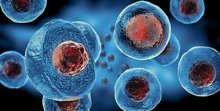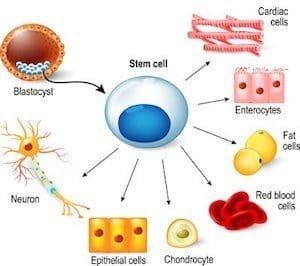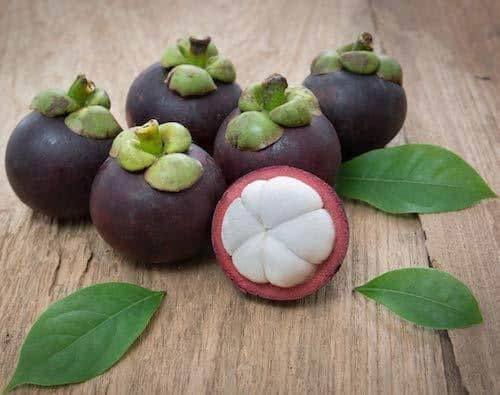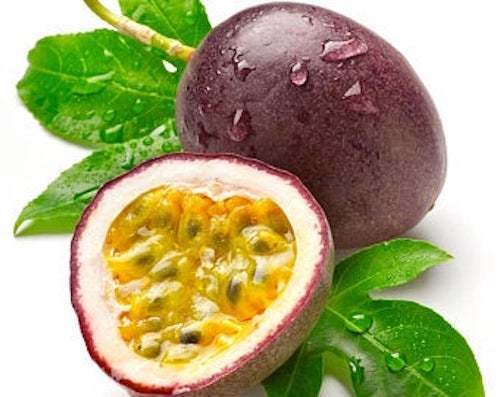Your Stem Cell Therapy Can Be Just 3 Plant Nutrients

Stem cell therapy is intriguing, because we have some notion that if we revitalize our stem cells, we revitalize ourselves. There is some truth to this, but the conventional way to get stem cell therapy is intrusive and very expensive. Why not let three over-the-counter plant nutrients do the job instead?
As reported by Life Extension Magazine, through the use of deep-learning artificial intelligence, scientists have recently identified three plant-based nutrients that can help reverse age-related damage to our existing pool of stem cells.
That’s a big deal.
The three big reasons this is a big deal are:
- Your stem cells are vital for cellular rejuvenation, but they are adversely impacted as we get older. Over time, our stem cells accumulate damage just like other cells do. This compromises their ability to keep tissues healthy and fully functional.
- When stem cells are rejuvenated they can replace the functional cells in our tissues that grow old and dysfunctional by producing new healthy cells.
- Being able to rejuvenate stem cells with over-the-counter plant nutrient supplements might replace the standard method of restoring stem cells, which is to harvest stem cells from your own body or elsewhere (like an embryo), inject them into a vein, much like a blood transfusion, after which they travel to the bone marrow, engraft (becomes successfully incorporated in the host body), and — hopefully — starts making new, normal blood cells. This costs many thousands of dollars.
So, if you could consume just three plant derivatives as your stem cell therapy, thus restoring healthy stem cell function, that would mean a lot to your anti-aging strategy.
The three plant nutrients are:
- Garcinol, a compound extracted from the fruit of the mangosteen tree;
- Piceatannol is found in fruits including red and white grapes, passion fruit, and blueberries; and
- Resveratrol, a nutrient found in the skin of red grapes.
Now, before you start searching on Google for links to buy them, it shouldn’t be surprising that that one of the companies that partnered on the research into these compounds, Life Extension, created a supplement product that contains the three plant nutrients. It’s called GEROPROTECT® Stem Cell, which you can find at Life Extension.com.
For those of you still here, let’s spend a bit more time here to explore whether or not supplementing with these three plant nutrients is a good idea.
Let’s take a look at:
- Why You Need A Healthy Reservoir of Stem Cells
- The Impact of Aging On Stem Cells
- The Science on Stem Cells Revitalization
- Your Stem Cell Therapy — 3 Plant-based Nutrients That Revitalize Stem Cells
Let’s get started with a short video about stem cells from FuseSchool:
Why You Need A Healthy Reservoir of Stem Cells
Like neurons and muscle cells, most cells in our tissues are specialized for specific functions. Neurons, for example, are cells in the nervous system specifically designed to respond to certain stimuli and conduct electrical impulses. Another example, muscle cells, have developed a distinct machinery to enable it to lengthen and contract, thereby creating movement.
These cells, and most others throughout the tissues of the body, are fixed — they cannot change types once they mature: A neuron is always a neuron, a muscle cell is always a muscle cell. Moreover, most of these kinds of cells cannot divide to produce more cells; instead, they die off and must be replaced by new cells.
Alas, most tissues also have a small population of stem cells (also referred to as tissue-specific progenitor cells). These mighty pluripotent cells are critically important for the maintenance back-up system that contribute to the health of every tissue, because stem cells act as a reservoir to replace old, damaged, or dying cells.
When specialized/functional cells in tissues stop working or are impaired by injury or disease, stem cells have the ability to develop into the required cell type to replace them, thus helping rejuvenate and repair the tissues themselves.
To work properly, stem cells must perform two basic functions:
- Self-renewal. Stem cells continue to divide, forming new stem cells. This maintains the available pool of stem cells and ensures there are enough cells to allow some to develop into specialized cells.
- Differentiation. When needed, stem cells transform into specialized functional cell types which replace ones that have been lost or damaged.
Now you know that when stem cells are working properly, they help maintain tissue and organ function and repair/defend tissues against disease, injury, and aging. But, as you also now know, like all our cells, stem cells get old and dysfunctional.
The Impact of Aging On Stem Cells
If stem cells were not impaired by age, they’d be a near-perfect system. Unfortunately, the role of stem cells — to keep tissues young and healthy — is compromised as we get older. Over time, just like with ordinary cells, stem cell damage accumulates, and they stop dividing effectively, lose the ability to replace old and damaged tissue cells, and begin to die.
The consequence of stem cell die-off is that:
- Tissues age more rapidly and lose their function.
- Physical frailty advances
- Cognitive abilities decline.
- Metabolism slows down.
- The body becomes more susceptible to age-related disease and dysfunction.
For most people, the deterioration of stem cells is inevitable, but perhaps it doesn’t have to be.
The Science on Stem Cells Revitalization
Research scientists have discovered ways to protect stem cells and restore their youthful function:
- Activating the enzyme AMPK—considered the “master regulator” of metabolism in the body. This improves energy balance in stem cells and leads to replacement of old, damaged proteins. [1,2]
- Inhibiting mTOR (an enzyme that regulates protein synthesis and cell growth) and activating FoxO (a protein that regulates the expression of genes). This limits the buildup of toxins and enhances autophagy, cellular “housekeeping” that keeps stem cells running smoothly. [3-5]
- Activating sirtuins, proteins that regulate cellular health, and protect and repair DNA. [6,7]
- Blocking the action of enzymes (called histone acetyltransferases) to reduce changes to genetic material that lead to cellular dysfunction. [8]
According to a partnership of scientists at Life Extension and InSilico Medicine’s deep-learning AI biotech group, three nutrients found in plants — garcinol, piceatannol, and resveratrol — have been shown to perform all these stem-cell-protecting actions.
Your Stem Cell Therapy — 3 Plant-based Nutrients That Revitalize Stem Cells
You know the value of stem cells, that they die over time and that typical methods of rejuvenation are out of reach for most people. You’ve also been told that three plant-based nutrients just might do the trick of keeping stem cells vital. Let’s dig into the specifics.
(1) Garcinol
Garcinol is a compound extracted from the fruit of the mangosteen tree.
As stem cells age, their expression of genetic material can be changed by a process known as histone acetylation. In some cases when this happens, histone acetylation increases the rate of stem cell aging and loss of function, leading to cellular dysfunction and increased risk for age-related disease.
Now, for this to happen, for histone acetylation to occur, an enzyme called histone acetyltransferase (HAT) is required, but If this enzyme is blocked, stem cells are not vulnerable to degradation.
Scientists are looking for synthetic drugs that can inhibit HAT, but there’s already a nutrient that can do it — Garcinol.
Preclinical studies have shown garcinol to be a potent HAT inhibitor, and by so doing, it reduces harmful chemical changes that affect gene expression. [9, 10]
Inhibiting HAT directly benefits stem cells by promoting the expression of genes involved in self-renewal and suppressing others that restrict it. In an ex vivo study (experiment done outside an organism) of human blood stem cells, garcinol caused their numbers to increase more than 4.5-fold. [9]
Garcinol may also promote the development of stem cells into specialized tissue cells. For example, Garcinol treatment promotes differentiation of rat neural stem cells into neurons.
(2) Piceatannol
Piceatannol is found in fruits including red and white grapes, passion fruit, and blueberries. Preclinical studies indicate that it has the ability to stimulate cellular housekeeping and sirtuin function, which has a beneficial impact on stem cells.22
In one study, human stem cells isolated from fat tissues were differentiated into mature fat cells in the presence or absence of piceatannol. The cells grown with Piceatannol displayed improved fat metabolism and healthier function, as well as reduced uptake of sugar which normally would be converted into fat. [11]
And in cell culture and adult mice, Piceatannol helped neural stem cells differentiate to produce new, specialized brain cells called astrocytes. [12]
(3) Resveratrol
Resveratrol, a nutrient found in the skin of red grapes, has long been known to have a wide range of health benefits. I recently wrote about a specific type of Resveratrol called Trans-Resveratrol, which is much more absorble than the regular kind most people supplement with, which is a type called cis-resveratrol.
Several recent studies have shown that Resveratrol may specifically help restore healthy stem cell function by:
- Activating SIRT1. In a study of human stem cells, resveratrol increased activity of SIRT1, a sirtuin protein linked to longevity and anti-aging. This resulted in improved self-renewal of the stem cells as well as differentiation into specialized cells. [13]
- Activating AMPK. One recent study showed that resveratrol helps osteogenic stem cell differentiation via AMPK activation. [14]
- Enhancing mitochondrial function. In aging mice and in cell culture, resveratrol restored healthier cellular metabolism by improving the function of mitochondria. [15]
- Inhibiting mTOR. Too much activity of the enzyme mTOR can lead to premature cellular aging. Mouse embryonic stem cells treated with resveratrol had decreased mTOR activity, making them more youthful and enhancing their self-renewal ability. [16]
In one recent study, researchers subjected mice to chemotherapy, a harsh treatment that accelerates the aging of ovarian stem cells. But when the animals were treated with Resveratrol, the loss of ovarian stem cells was alleviated. [17]
Protecting stem cells translates into clear improvements in tissue function. In a rat animal model, scientists created an injury to the aorta, the artery that carries blood from the heart to the rest of the body. In the rats treated with Resveratrol, their stem cells were better able to replace the damaged endothelial cells (cells that line the interior surface of blood vessels), resulting in accelerated healing/repair of the injured artery. [18]
In humans, Resveratrol treatment reduced mean fat cells’ size and improved adipogenesis (differentiation of pre-adipocytes into fat cells) related to improved sensitivity of tissues to insulin. [19]
Resveratrol and Piceatannol are both stilbenes, close relatives. In one cell study, Resveratrol and Piceatannol worked synergistically to enhance each other’s ability to stimulate cellular housekeeping and sirtuin function. [14]
If you want an alternative to Life Extension’s GEROPROTECT® Stem Cell, you may have to buy each of these three stem cell therapy compounds individually. If so, these are good brands to consider:
- Orphic Nutrition Garcinia
- Zetpil Piceatannol
- Doctor’s Best Trans-Resveratrol or ProHealth’s 1000mg Trans Resveratrol
Note: The principle antioxidant substance of Garcinia (the first product linked to the above three bullets) is Garcinol. More about that here.
Your Takeaway On Self-administered Stem Cell Therapy
Remember these three things:
- The good news is that stem cells are present in many tissues, providing a built-in means to replace dead, dying, and damaged cells, rejuvenating the tissue. The bad news is that the capacity of stem cells to support the rest of the cells in our body degrades as we age.
- Scientists have identified three nutrients found in plants that have a powerful impact on stem cell health and functions: Garcinol, Piceatannol and Resveratrol. There’s evidence that each of these compounds protects and revitalizes stem cells, enhancing their self-renewal and their ability to grow into mature tissue cells.
- Garcinol, Piceatannol and Resveratrol are widely available supplements. If you want to try resveratrol, I recommend you take the trans-resveratrol type.
References
- Avolio E, Gianfranceschi G, Cesselli D, et al. Ex vivo molecular rejuvenation improves the therapeutic activity of senescent human cardiac stem cells in a mouse model of myocardial infarction. Stem Cells. 2014 Sep;32(9):2373-85.
- Burkewitz K, Zhang Y, Mair WB. AMPK at the nexus of energetics and aging. Cell Metab. 2014 Jul 1;20(1):10-25.
- Ho TT, Warr MR, Adelman ER, et al. Autophagy maintains the metabolism and function of young and old stem cells. Nature. 2017 Mar 9;543(7644):205-10.
- Ito K, Suda T. Metabolic requirements for the maintenance of self-renewing stem cells. Nat Rev Mol Cell Biol. 2014 Apr;15(4):243-56.
- Warr MR, Binnewies M, Flach J, et al. FOXO3A directs a protective autophagy program in haematopoietic stem cells. Nature. 2013 Feb 21;494(7437):323-7.
- Liu X, Hu D, Zeng Z, et al. SRT1720 promotes survival of aged human mesenchymal stem cells via FAIM: a pharmacological strategy to improve stem cell-based therapy for rat myocardial infarction. Cell Death Dis. 2017 Apr 6;8(4):e2731.
- Yuan HF, Zhai C, Yan XL, et al. SIRT1 is required for long-term growth of human mesenchymal stem cells. J Mol Med (Berl). 2012 Apr;90(4):389-400.
- Jung JW, Lee S, Seo MS, et al. Histone deacetylase controls adult stem cell aging by balancing the expression of polycomb genes and jumonji domain containing 3. Cell Mol Life Sci. 2010 Apr;67(7):1165-76.
- Nishino T, Wang C, Mochizuki-Kashio M, et al. Ex vivo expansion of human hematopoietic stem cells by garcinol, a potent inhibitor of histone acetyltransferase. PLoS One. 2011;6(9):e24298.
- Balasubramanyam K, Altaf M, Varier RA, et al. Polyisoprenylated benzophenone, garcinol, a natural histone acetyltransferase inhibitor, represses chromatin transcription and alters global gene expression. J Biol Chem. 2004 Aug 6;279(32):33716-26.
- Carpene C, Pejenaute H, Del Moral R, et al. The Dietary Antioxidant Piceatannol Inhibits Adipogenesis of Human Adipose Mesenchymal Stem Cells and Limits Glucose Transport and Lipogenic Activities in Adipocytes. Int J Mol Sci. 2018 Jul 17;19(7).
- Arai D, Kataoka R, Otsuka S, et al. Piceatannol is superior to resveratrol in promoting neural stem cell differentiation into astrocytes. Food Funct. 2016 Oct 12;7(10):4432-41.
- Wang X, Ma S, Meng N, et al. Resveratrol Exerts Dosage-Dependent Effects on the Self-Renewal and Neural Differentiation of hUC-MSCs. Mol Cells. 2016 May 31;39(5):418-25.
- Pietrocola F, Marino G, Lissa D, et al. Pro-autophagic polyphenols reduce the acetylation of cytoplasmic proteins. Cell Cycle. 2012 Oct 15;11(20):3851-60.
- Lv YJ, Yang Y, Sui BD, et al. Resveratrol counteracts bone loss via mitofilin-mediated osteogenic improvement of mesenchymal stem cells in senescence-accelerated mice. Theranostics. 2018;8(9):2387-406.
- Li N, Du Z, Shen Q, et al. Resveratrol Enhances Self-Renewal of Mouse Embryonic Stem Cells. J Cell Biochem. 2017 Jul;118(7):1928-35.
- Wu M, Ma L, Xue L, et al. Resveratrol alleviates chemotherapy-induced oogonial stem cell apoptosis and ovarian aging in mice. Aging (Albany NY). 2019 Feb 14;11(3):1030-44.
- J G, Cq W, Hh F, et al. Effects of resveratrol on endothelial progenitor cells and their contributions to reendothelialization in intima-injured rats. J Cardiovasc Pharmacol. 2006 May;47(5):711-21.
- Konings E, Timmers S, Boekschoten MV, et al. The effects of 30 days resveratrol supplementation on adipose tissue morphology and gene expression patterns in obese men. Int J Obes (Lond). 2014 Mar;38(3):470-3.
Last Updated on February 18, 2020 by Joe Garma








